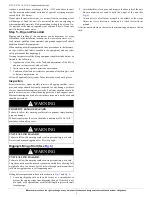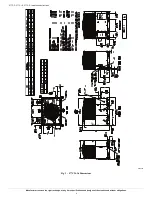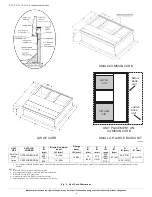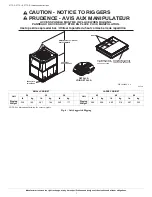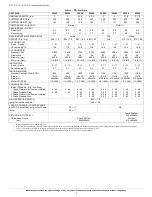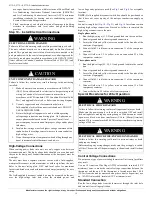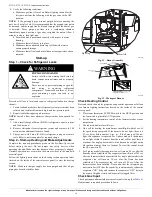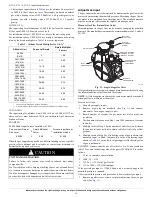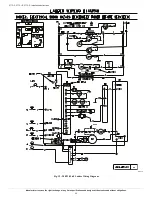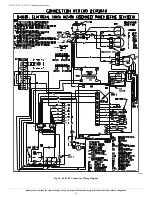
577C--C, 577C--E, 577C--F: Installation Instructions
Manufacturer reserves the right to change, at any time, specifications and designs without notice and without obligations.
10
.
Install the flue hood as follows:
1. This installation must conform with local building codes and with
NFPA 54/ANSI Z223.1 National Fuel Gas Code (NFGC), (in
Canada, CAN/CGA B149.1, and B149.2) latest revision. Refer to
Provincial and local plumbing or wastewater codes and other
applicable local codes.
2. Remove flue hood from shipping location (inside the return section
of the blower compartment-see
). Remove the return duct
cover to locate the flue hood. Place flue hood assembly over flue
panel. Orient screw holes in flue hood with holes in the flue panel.
3. Secure flue hood to flue panel by inserting a single screw on the top
flange and the bottom flange of the hood.
Step 8 – Install Gas Piping
The gas supply pipe enters the unit through the access hole provided.
The gas connection to the unit is made to the 1/2-in. (12.7 mm) FPT gas
inlet on the gas valve.
Install a gas supply line that runs to the heating section. Refer to the
NFGC for gas pipe sizing. Do not use cast-iron pipe. It is recommended
that a black iron pipe is used. Check the local utility for
recommendations concerning existing lines. Size gas supply piping for
0.5 IN. W.C. maximum pressure drop. Never use pipe smaller than the
1/2-in. (12.7 mm) FPT gas inlet on the unit gas valve.
For natural gas applications, the gas pressure at unit gas connection must
not be less than 4.0 IN. W.C. or greater than 13 IN. W.C. while the unit is
operating. For propane applications, the gas pressure must not be less
than 11.0 IN. W.C. or greater than 13 IN. W.C. at the unit connection.
A 1/8-in. (3.2 mm) NPT plugged tapping, accessible for test gauge
connection, must be installed immediately upstream of the gas supply
connection to the gas valve.
When installing the gas supply line, observe local codes pertaining to
gas pipe installations. Refer to the NFPA 54/ANSI Z223.1 latest edition
(in Canada, CAN/CGA B149.1).
NOTE:
In the state of Massachusetts:
1. Gas supply connections MUST be performed by a licensed plumber
or gas fitter.
2. When flexible connectors are used, the maximum length shall not
exceed 36 in. (915 mm).
3. When lever handle type manual equipment shutoff valves are used,
they shall be T-handle valves.
4. The use of copper tubing for gas piping is NOT approved by the
state of Massachusetts.
In the absence of local building codes, adhere to the following pertinent
recommendations:
1. Avoid low spots in long runs of pipe. Grade all pipe 1/4 in. (6.35
mm) for every 15 ft (4.6 m) of length to prevent traps. Grade all
horizontal runs downward to risers. Use risers to connect to heating
section and to meter.
2. Protect all segments of piping system against physical and thermal
damage. Support all piping with appropriate straps, hangers, etc.
Use a minimum of one hanger every 6 ft (1.8 m). For pipe sizes
larger than 1/2 in., follow recommendations of national codes.
3. Apply joint compound (pipe dope) sparingly and only to male
threads of joint when making pipe connections. Use only pipe dope
that is resistant to action of liquefied petroleum gases as specified
by local and/or national codes. Never use Teflon tape.
4. Install sediment trap in riser leading to heating section (See
).
This drip leg functions as a trap for dirt and condensate.
5. Install an accessible, external, manual main shutoff valve in gas
supply pipe within 6 ft (1.8 m) of heating section.
6. Install ground-joint union close to heating section between unit
manual shutoff and external manual main shut-off valve.
7. Pressure test all gas piping in accordance with local and national
plumbing and gas codes before connecting piping to unit.
C99020
Fig. 8 – Sediment Trap
NOTE:
Pressure test the gas supply system after the gas supply piping
is connected to the gas valve. The supply piping must be disconnected
from the gas valve during the testing of the piping systems when test
pressure is in excess of 0.5 psig. Pressure test the gas supply piping
system at pressures equal to or less than 0.5 psig. The unit heating
section must be isolated from the gas piping system by closing the
external main manual shutoff valve and slightly opening the
ground-joint union.
WARNING
!
CARBON MONOXIDE POISONING HAZARD
Failure to follow this warning could result in personal injury or death.
The venting system is designed to ensure proper venting. The flue hood
assembly must be installed as indicted in this section of the unit
installation instructions.
OUT
TEE
NIPPLE
CAP
IN
3˝ MIN
Table 2 – Gas Flow Capacity
*
*. Capacity of pipe in cu ft of gas per hr for gas pressure of 0.5 psig or less. Pressure drop of 0.5-IN. W.C. (based on a 0.60 specific gravity gas). Refer to
and National Fuel
Gas Code NFPA 54/ANSI Z223.1.
NOMINAL
IRON PIPE
SIZE (IN.)
INTERNAL
DIAMETER
(IN.)
LENGTH OF PIPE FT (m)
†
†. This length includes an ordinary number of fittings.
10
(3)
20
(6)
30
(9)
40
(12)
50
(15)
60
(18)
70
(21)
80
(24)
90
(27)
100
(30)
125
(38)
150
(46)
175
(53)
200
(61)
1/2
.622
175
120
97
82
73
66
61
57
53
50
44
40
—
—
3/4
.824
360
250
200
170
151
138
125
118
110
103
93
84
77
72
1
1.049
680
465
375
320
285
260
240
220
205
195
175
160
145
135
1-1/4
1.380
1400
950
770
600
580
530
490
460
430
400
360
325
300
280
1-1/2
1.610
2100
1460
1180
990
900
810
750
690
650
620
550
500
460
430



